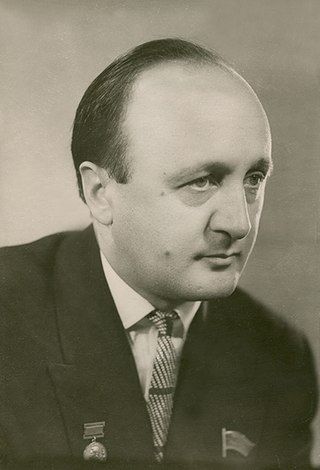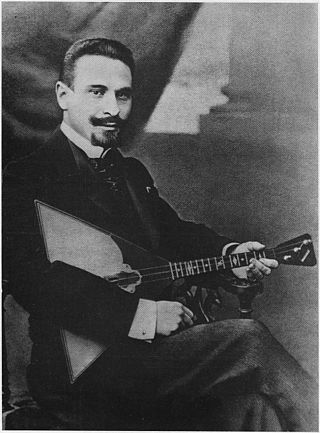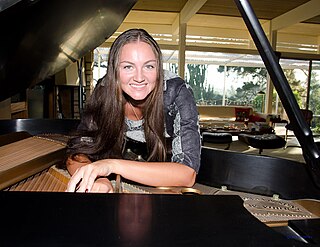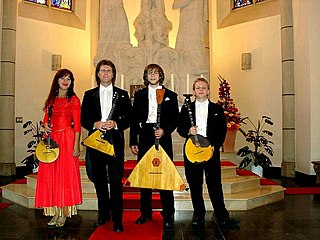
The balalaika is a Russian stringed musical instrument with a characteristic triangular wooden, hollow body, fretted neck, and three strings. Two strings are usually tuned to the same note and the third string is a perfect fourth higher. The higher-pitched balalaikas are used to play melodies and chords. The instrument generally has a short sustain, necessitating rapid strumming or plucking when it is used to play melodies. Balalaikas are often used for Russian folk music and dancing.
Pamela Frank is an American violinist, with an active international career across a varied range of performing activity. Her musicianship was recognized in 1999 with the Avery Fisher Prize, one of the highest honors given to American instrumentalists. In addition to her career as a performer, Frank holds the Herbert R. and Evelyn Axelrod Chair in Violin Studies at the Curtis Institute of Music, where she has taught since 1996, and is also an adjunct professor of Violin at the University of Southern California's Thornton School of Music since 2018.

The domra is a long-necked Belarusian, Russian, and Ukrainian folk string instrument of the lute family with a round body and three or four metal strings.

Russian folk music specifically deals with the folk music traditions of the ethnic Russian people. Russian Russian folk music is used as the basic foundation for the creation of all Russian professional music.

David Shifrin is an American classical clarinetist and artistic director.

Fikret Mashadi Jamil oghlu Amirov was a prominent Soviet and Azerbaijani composer.

A mandolin orchestra is an orchestra consisting primarily of instruments from the mandolin family of instruments, such as the mandolin, mandola, mandocello and mandobass or mandolone. Some mandolin orchestras use guitars and double-basses instead of, or as well as, the lower mandolin-family instruments.
Dalit Hadass Warshaw is a New York-based composer, pianist, and thereminist. Previously on the composition and music theory faculty of Boston Conservatory, she currently serves on the composition faculty at Juilliard and CUNY-Brooklyn College. Her works have been performed by dozens of orchestral ensembles, including the New York Philharmonic and Israel Philharmonic Orchestras, the Boston Symphony, the Cleveland Orchestra, the Houston Symphony, the Y Chamber Orchestra, the Colorado Symphony and the Albany Symphony Orchestra. In April 2006, her piece After the Victory for orchestra and chorus, was premiered by the Grand Rapids Symphony and the North American Choral Company. Her first recording, entitled "Invocations" was released by Albany Records in 2011. Her first piano concerto, Conjuring Tristan, was commissioned by the Grand Rapids Symphony in 2014. The work was inspired by Richard Wagner's Tristan und Isolde, as well as by Thomas Mann's novella Tristan. The piece received its world premiere in January 2015, with Warshaw as the soloist.

Vasily Vasilievich Andreyev was a Russian musician responsible for the modern development of the balalaika and several other traditional Russian folk music instruments, and is considered the father of the academic folk instrument movement in Eastern Europe. His accomplishments included:
Oxana Yablonskaya is a Russian pianist who has had an active international performance career since the early 1960s. She began her career in the USSR and, although winning several important competitions in the West, was denied permission by the Soviet government to accept any performance engagements outside of the Soviet bloc. Frustrated by her career limitations, she emigrated to the United States in 1977. Described by The New York Times as an "internationally known virtuoso" and "one of the country's most distinguished musical residents", Yablonskaya has toured in concert and recital throughout the world and has made numerous recordings. She taught as a member of the piano faculty at the Juilliard School for more than 30 years, until 2009.
Stephanie Ann Chase is an American classical violinist.
Jennifer Frautschi is an American violinist. A recipient of an Avery Fisher Career Grant, she is currently Artist-in-Residence at Stony Brook University. She plays a 1722 Antonio Stradivari violin known as the "ex-Cadiz," on loan from a private American foundation.

Elena Fomicheva is a classical pianist, soloist and accompanist.

Avi Avital is an Israeli mandolinist. He is best known for his renditions of well-known Baroque and folk music, much of which was originally written for other instruments. He has been nominated for a Grammy award and in 2013 signed a record agreement with Deutsche Grammophon.
Dorina Frati is an Italian classical mandolin player. She performs regularly with European orchestras such as The Philharmonic of La Scala, the National Academy of Santa Cecilia, the National Orchestra of RAI, the Chamber Orchestra of Mantua and the Philharmonic of Rome. She completed her studies with Giuseppe Anedda, graduating from the Pollini Conservatory of Padua, Italy.

Kharkiv National University of Arts named after I. P. Kotlyarevsky is the leading music and drama institution of higher education in Ukraine. The university trains about 900 undergraduates, graduates and postgraduates in music and theatre art. It enjoys Level IV accreditation, which is the highest under Ukraine's national standards, and is licensed to train foreign students.

Quartet Skaz is a concert quartet employing Russian folk instruments: the prima domra, prima balalaika, alto domra, and bass balalaika.
Alon Sariel is an Israeli mandolinist, lutenist and conductor.

Tessa Lark is an American concert violinist.

Following its invention and development in Italy the mandolin spread throughout the European continent. The instrument was primarily used in a classical tradition with mandolin orchestras, so called Estudiantinas or in Germany Zupforchestern, appearing in many cities. Following this continental popularity of the mandolin family, local traditions appeared outside Europe in the Americas and in Japan. Travelling mandolin virtuosi like Carlo Curti, Giuseppe Pettine, Raffaele Calace and Silvio Ranieri contributed to the mandolin becoming a "fad" instrument in the early 20th century. This "mandolin craze" was fading by the 1930s, but just as this practice was falling into disuse, the mandolin found a new niche in American country, old-time music, bluegrass and folk music. More recently, the Baroque and Classical mandolin repertory and styles have benefited from the raised awareness of and interest in Early music.












